Another thing that happens as the seasons change is that my mother inadvertently saw a commercial announcing a "Countdown to Vancouver Winter Olympics 2010!!!", and has pretty much glued herself and, on occasion, me, to the television to witness the events of non-contact sports and root for the home team, as it were.
Let's see, what interesting things have I seen recently? They had a bunch of rhythmic gymnasts (read: hot ballet dancers with little spinny things that somehow qualify it as an Olympic sport) come to my birth prefecture to compete in the Ultimate World Championship Final... thing... So that was neat. And also congratulation to my countryman, Uchimura Kohei, for placing first by a landslide and being the All-Around Mens' Gymnastic Champion.
Needless to say, I don't really know all that much about sports programs that don't involve Lane Kiffin and/or men bashing each other in the head with steel chairs or something else equally cool, but I took in what I could. However, when it came time for the Figure Skating portion of the pre-Olympic coverage, I was present to catch my beloved Ando Miki and Queen Yu-Na, and was reminded once again of the existence of one Mister Nobunari Oda.
That's right, he's a male figure skater from Japan, lauded on occasion as the best male figure skater ever, so I figured it would be fun if I expounded on him a bit more with interesting trivia and cute pics!
Just kidding. I hope you aren't actually expecting one of my long-winded entries to really be on some ice skating dude and his pictures. It's fall break, we have to keep our brains active!
Perhaps I forgot to mention that Nobunari is the descendant of the first unifier of Japan and possibly greatest daimyo of the Sengoku Period ever, Oda Nobunaga. That's right! It's time for a samurai lesson. The first in a series of entries I will be making on notable people of the Warring States Period. It's something I'd like to call
The Sengoku Spotlight
But I feel bad that maybe some of you really wanted to learn about Nobunari, and are now being overloaded with historical information, so to try to keep it fun and entertaining, I'll go ahead and throw in some shit on Nobunari as well. Let's call it:
The Oda, Past and Present: A Comparison and Contrast
First off, let me give you some basic information on Nobunaga. He lived during the Sengoku Period, an era in Japanese history where pretty much everything that had been established beforehand had been pissed away and dissolved into basically a false since of order, and all of the local lords of the provinces (daimyo) made a run for the seat to become the ruler of all the land. Nobunaga was just such a daimyo, and would go on to be remembered as the man who laid the groundwork for the unification of the country, a feat he most likely would have achieved had he not been killed (more on that later). The three major unifiers are recognized as Nobunaga, and two of his retainers who had it out after his death, Toyotomi Hideyoshi and Tokugawa Ieyasu. You may remember some of it from this entry.
Anyway, Nobunaga is popularly portrayed in modern media as the ultimate villain, a cruel controller of men, and the foolish leader of the podunk little province of Owari that somehow seized power through heartless will, dumb luck, and trickery. In fact, his names at the time were that of "The Fool of Owari", and later "The Demon King". But in reality, those titles are what he wanted to be called, and in fact don't reflect his actions as some history books may suggest. Regardless, his story makes for some great reading. It's as if he lived his whole life in the moment, thinking, "This is gonna look great when Kurosawa Akira directs a re-enactment of it someday..."
So after all that, some four hundred years later, his family name would live on to be remembered by popular young figure-skating celebrity, Nobunari.
This guy:
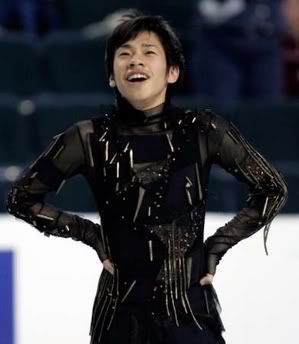
Yeeeeeah.
Let's see how history has preserved itself.
The First Result On Google Image Search:
Nobunaga:

His official portrait. That's a good enough start. Note the clothing, and most importantly, the crests on it. This tells us that, in this photo, Nobunaga is pretty much at the top of his game.
Nobunari:

...Let's just move on.
Hobbies & Interests
Nobunari:
OK, well I actually did look them up, alright? He enjoys:
- reading
- watching movies
- listening to music
- internet shopping
There you go, fascinating.
Nobunaga:
Nobunaga was actually quite well-known for his hobbies. He had an extremely competitive spirit, which undoubtedly contributed to his successes in battle, but also gave him a weird compulsion to collect things. I mean really collect things.
His father had died when he was a young teenager, and Nobunaga's own family attempted to wrest the leadership of the clan from him, his own mother showing favour for his brother instead. But Nobunaga proved adept enough to retain the leadership, at least, and quickly became infamous for his outlandish actions. It is said that he had a temper tantrum at his father's funeral, and threw incense at the altar. He was also known for dressing like a madman, and riding around town eating melons, spitting the seeds along the road wherever he pleased, and enjoying the sites.
One of his favourite activities included practicing horsemanship. It had always been extremely popular among the nobles, especially in the Heian period, the most decadent period, where all ridiculously lavish and useless hobbies were formed. Horse races and horseback archery were certainly a display of skill and mastery, traditions the lords and warriors of Nobunaga's time enjoyed partaking in. A notable story focusing on his love of horses is described in history as follows:
Nobunaga had a favourite horse named Uzuki. He would often race Uzuki around his castle grounds, but as Uzuki aged, Nobunaga's emerging temper would show itself. He would drag the horse around by his nose and chastise it, or grab its tongue out of its mouth and say it looked ugly. One day, when he was doing such a thing, he was suddenly overtaken by another horse and rider, that of his soldier, Hirate Gorozaemon. He jumped back onto his horse and almost beat the animal to death so that he wouldn't be one-upped during his favourite activity in his own castle. When Gorozaemon warned Nobunaga about whipping and riding the elderly horse so hard, Nobunaga mocked him, calling him a coward. Gorozaemon, who had better riding skills and a younger horse, pretty much took that as a challenge, and managed to race forward and once again overtake Uzuki, despite the horse being famous far and wide among the Oda's allies and enemies alike. After being overtaken once more, Nobunaga jumped off of his horse and started screaming in his embarrassment.
After a moment, Nobunaga summoned Gorozaemon and complimented the horse, then offered to take it off his hands. Gorozaemon refused, saying that he loved the horse, and it was extremely useful to him in battle, battles he fought for Nobunaga. Nobunaga continued trying to take the horse from him, since it would be impolite to flat-out demand that Gorozaemon turn over the horse to him, but Gorozaemon stated clearly that he would not give up his favourite horse, a fine horse that served him well and was best suited to battle, and not to being ridden around and having persimmons and melon seeds dripped all over it.
"Oh shit.", would have been my reaction, had I been a retainer witnessing this argument.
Now, Gorozaemon's father, Hirate Nakatsukasa, was a senior retainer of the Oda clan, and had served Nobunaga's father. On his deathbed, Nobunaga's father had bequeathed that Nakatsukasa should care for Nobunaga, and he did, raising him and favouring him instead of his own sons. When Nakatsukasa heard what Gorozaemon had done, he summoned his son to his home and asked him of his reasons. Gorozaemon voiced that Nobunaga often acted foolish, a fear and shame the entire province had, as the enemies vying for control of the region amassed around them. The next morning, Nakatsukasa's body was found along with a note that praised and respected his young lord, Nobunaga. However, Nakatsukasa had committed seppuku, the honourable way to die, in this instance in a humble and helpless protest to his lord.
Needless to say, this was a serious wake-up call to Nobunaga, who felt terrible that his actions had killed the man who had been so important to his father, and who had raised and guided him after taking over the clan as a teenager. He reconciled with Gorozaemon and built a temple in Nakatsukasa's honour. But he didn't give up his love of obsessively collecting things.
Later, when he was planning to attack a city run by lowly merchants, a cunning such man, Imai Sokyu, who had previously gained favour from Nobunaga and was granted a title, attempted to convince the city to submit to the Oda instead of fight back. He met with Nobunaga and many of his men, and held a tea party for them. As a well-trained master of the Tea Ceremony, a very elegant ritualistic performance, Sokyu held the rites, and gifted Nobunaga with a beautiful antique tea set. Nobunaga, who saw the value of such a delicate and peaceful ceremony to be performed in the hectic times of the Sengoku era, would decide to spare the city and began to collect tea sets. As he continued conquest, it would become popular and symbolic to gift Nobunaga with a tea set, meaning that they would revere and submit to him with that offering.
Once, after a very intriguing and scandalous campaign, a guardian of the clan Nobunaga was attacking was forced to surrender to the Oda. The man, Matsunaga Hisahide, instead opted to commit suicide, rather than give Nobunaga the satisfaction of once again besting his men. But before he committed seppuku, Hisahide took an extremely prized and priceless tea set and hurled it into the wall, breaking it, as he shouted "I'd rather my tea-set come to hell with me than let Nobunaga have it!" He then killed himself.
But not all of Nobunaga's OCD ways were tinged with violence and badassery. Nobunaga also enjoyed dancing.
Well, sort of.
Over in this entry, I talk about how symbolic and prevalent Kabuki and Noh imagery is. Like the tea ceremony, sacred and ritualized things struck a cord with the daimyo and warriors in the troubled time. One such play was Atsumori, specifically the dance and song it was most known for, and many daimyo would perform it. However, over the course of history, it has come to be synonymous with Nobunaga.
Nobunaga was, as I mentioned, the lord of the rather small and unimportant province of Owari. At this time, when Nobunaga was still viewed as an insane young child of no real threat or valor, the largest and most powerful clan were the Imagawa. The Imagawa daimyo, Yoshimoto, decided that since he was the biggest dog in the yard, he would "go to Kyoto to meet with the Emperor". This was really a play for power, and Nobunaga's little province was between Yoshimoto's Suruga and the Capital. He basically meant to pick Nobunaga off along the way, no problem.
Nobunaga got word that Yoshimoto was approaching (in battle formation) with 50,000 men. Of course, Yoshimoto and his flamboyant self had purposefully leaked this information, and it was really more like 35,000. But this was nothing to sneeze at, because Nobunaga basically had no chance. He would end up going against the Imagawa with a main force of around maybe 3,000 total.
Nobunaga, who was still young and had not yet secured a vast following of allies and hostages like Yoshimoto, resigned himself to death and called for his servant-woman to play a hand-drum for him. In the early morning, he took his fan and performed the Atsumori, before leaving his castle with only a few men.
Ningen gojuunen
Geten no uchi o kurabureba
Yume maboroshi no gotokunari
Hitotabi sho o uke
Messenu mono no arubekika
And a translation of the lyrics:
A man has but 50 years under heaven
It is nothing compared to the age of this world
Life is but a fleeting dream, an illusion
Is there anything that lasts forever?
Nobunaga would be graced with the greatest luck and was victorious in the battle, the first step that cemented his legacy and capability as a commander. Though he would perform the Atsumori many times over the course of his life, it was often reminiscent of the initial gambit he had taken in going up against the much larger, more experienced and powerful clan, when he and his faithful retainers had submitted themselves to the fate of death, and won the battle in a magnificent fashion.
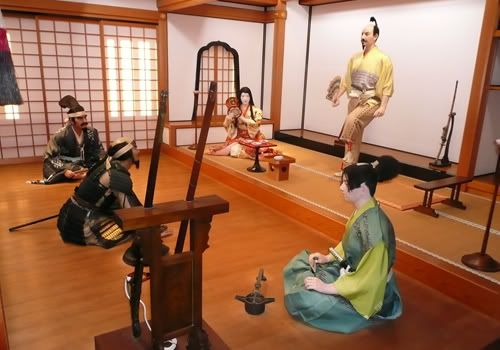
These figures stand in Nobunaga's castle, Kiyosu-jo, showing that very depressing and symbolic scene. Nobunaga is obviously the one with the fan, and you can also see his retainers, his serving-girl Sai, and his page Ranmaru. More about Ranmaru later.
Here is a closeup of Nobunaga.
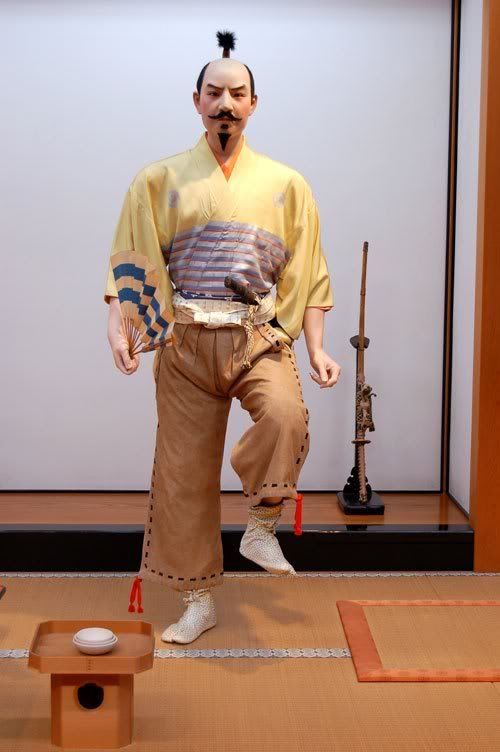
Because he is so famous as a fan of the dance, and the symbolism of that morning when it was first performed, Nobunaga will almost always perform it in media when he is portrayed. Here he is performing the Atsumori in the opening of one of my favourite video games, Sengoku Musou (Samurai Warriors).
And in possibly my favourite movie of all time, Kagemusha, he performs the dance when he receives the news that his longtime rival, Takeda Shingen, is dead.
(click here)
Notable Banners
Nobunaga:
I know I covered a lot about crests and the way such things were displayed during this time back in the other entry, but I will add a little more on to that thought here.
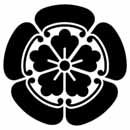
This is the mon of the Oda clan, the mokko. It represents a flower surrounded by a nest. This is what you will see everywhere on Nobunaga's things, though he wasn't so fast and loose with it like many generals at the time who put it on literally everything, even things that really had absolutely no need for a crest on it. However, his mon was of course used on Nobunaga's important clothing, on his ornamentally decorated saddles, and on battle banners and curtains and that sort of thing. Nobunaga also was granted the use of the go-shichi-no-kiri, the Prime Minister's paulownia flower that you saw on his clothing in his official portrait. Another mon used by Nobunaga was his personal battle crest, which was a coin.

This coin, in fact. Chinese currency was used at the time, and one legend states that Nobunaga just pulled this coin out, pressed it as his banner, and used that. When asked, he said it was his "lucky coin". A more romanticized version tells us that, just like the Atsumori, on the day he went to battle against impossible odds in the Imagawa clan, Nobunaga took out the coin and proclaimed to his closest men that Buddha was watching, and if he saw it fit to let the Oda survive, he would give him a sign in the form of 'heads'. He then flipped the coin and the men were awestruck or even inspired during the horrific battle, and, after their glorious victory, told Nobunaga that he should thank the gods for the auspicious sign. Nobunaga then said that the gods did nothing, and once more brandished the coin, his 'lucky coin', that had a head on both sides. It was very like Nobunaga to express such sentiment, saying that fate should not be left to the gods, and instead should be taken by oneself. This very Zen way of thought would come to be associated with Nobunaga, and these types of moments would go down in history painting him in a light of nobility and of inspiration.
Nobunari:
OK, so I'll admit this whole 'banners' thing was really just an excuse for a mini-rant. During the figure skating competition, there were huge signs and banners hung up in support of many of the skaters performing. Now, I don't watch it enough to know, but do they do this sort of thing often? Or was it a special occasion? Or was the place that was hosting like, really into decorating? Because seriously, I was pausing and watching the signs waaaaay more than I was looking at any of the actual skating. They were the most low-budgeted, terrible looking banners I'd ever seen. I guess they were fan-made, since they were all in their respective languages, but the overall look and feel was that of the sort of forced decorating you might see in a Lifetime movie. You know how it's like, the teenage boy's room, and he has posters and shit all over, but they're like a really family-friendly depiction of a 'metal' band called "DARK ROCK" or something, next to some photo of a "centerfold" but she's fully dressed and covered more than the mom in the movie and also looks really normal, like it was just cut out of an Old Navy ad or something, so you can tell it was designed by some 50 year old woman working on the movie who wanted to get the point across but didn't want to be too edgy and also didn't really have any idea what sort of things teenage boys might be into. That's how these signs looked.
It needs to be said that, in all of the mens' photos, nobody was wearing a shirt. They're all gems, each and every one of them, but I'll describe my favourite ones.
First off, there was one that just said BRIAN ICE, and that was pretty awesome, but then there was another sign that expanded on the concept and said "Nothing Between Brian & Ice", so I don't really know what was happening there. Even Asada Mao's poster was pretty bootleg, featuring this 'artistic' drawing of her gazing all dreamy-eyed into the distance while a white wolf looked on. I get where they were going with that, but the wolf's face was considerably larger than hers, and it kind of looked like the artist had messed up halfway through, and then tried to fix the other half to even out the face, so it ended up with this concerned and slightly confused-looking wolf pasted to the side of the rink.
Kim Yu-Na, who is obviously the very best and has a lot of fans who are very proud of her, had the most signs. A lot of them were pretty straight forward, and read like they'd just been snatched right out of a chat log, including "Flying~! Queen Yu~Na~!! ~^^*" That's the actual exact text of the sign, I made sure to write it down. But the abundance of them were black-and-white glamour shots. Like serious glamour shots, they were so airbrushed they looked like 1980's pop albums, just huge posters of Yu-Na staring pointedly over her shoulder or to the heavens or that one skating position they always show absolutely everyone in, with the leg up and the hands out.
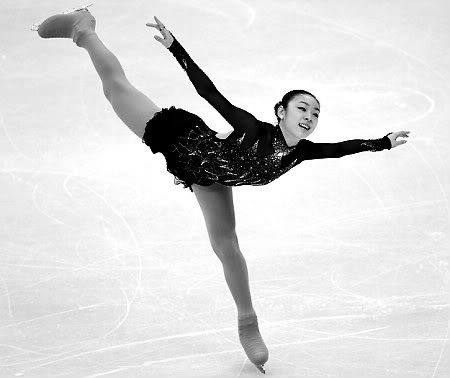
Yeah, that's the one. But way more serious and obviously staged, with a sole spotlight shining on her that she gazes up into, subtle sort of imagery like that. And by subtle, I mean "as obvious as a sledgehammer to the eyeballs".
Speaking of sledgehammers, there was also this shirtless guy wearing lederhosen and holding a hammer. And this other guy who was flying over a rainbow in disco pants, doing the same pose as Yu-Na up there.
So you're probably wondering what in the blue hell terrible thing they got Nobunari to do for his vanity poster. Well, he just had the one.
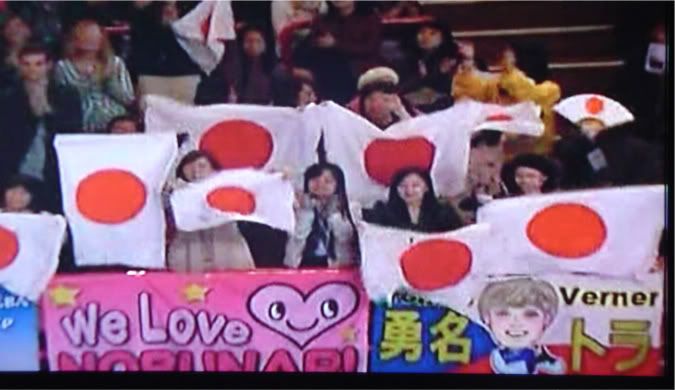
It's exactly what it looks like.
Pretty Boy He Has Decimated
Nobunaga:
As mentioned, the battle of Okehazama was the first huge leap for Nobunaga's fame. Imagawa Yoshimoto entered Owari and easily started taking forts, which succeeded in bringing Nobunaga out to fight. Nobunaga went as far as the temple of Zenshouji to make his battle plan. He didn't have enough men to charge the Imagawa, nor even to hold the temple, so he was forced to launch a surprise attack. Nobunaga left his banners at the temple, to make it appear that he was camped there, then he and a force of just slightly over 1,000 men advanced. What they found were the Imagawa atop a knoll called Dengakuhazama, surrounded by mountains.
Yoshimoto arrived and, noting that it was a very hot day, lay down on a leopard-skin mat in the grass, had sake and tea, and commanded that his supplies be unpacked. This basically entailed a small celebration over the victory of taking Owari, complete with song, dance, musical performance, blessings, and later a moon-viewing ceremony in Nobunaga's castle. About this time, it began to thunder, and then rain. As the thunderstorm progressed, the Imagawa began to drink more, happy that the rain would cool everything down, since it was just so hot that day. A huge din rose throughout Dengakuhazama, the Oda arriving under the cover or the storm, and the subsequent fleeing of the Imagawa troops. Yoshimoto came out from his encampment fuming, ordering his men to keep it down, at which point an Oda officer, Mori Shinsuke, lopped his head right off.
The whole thing makes Yoshimoto seem rather idiotic and hedonistic. The fact of the matter is that he notoriously was. First off, here is his mon:
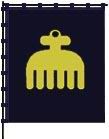
Called akaitori, the crest bears a resemblance to a delicate woman's comb. An alternate tale, however, is that a beautiful lady was seen riding a horse, and the horse went so fast that her many layers of dresses fanned out behind her, also resembling a lovely comb, and did not become dirty along the ground because of the speed and grace.
It all sounds pretty flowery and useless, right? Yeah, this sort of imagery once again comes straight to us from the Heian period. Yoshimoto was a big fan of the Heian period. His appearance is usually mentioned for how bizarre it all was: he is described as carrying elaborate swords and wearing flamboyant clothing, even going so far to equip his officers in similar apparel. He also took to powdering his face white, painting his lips to a feminine shade of purple, and blackening his teeth just as the nobles of Kyoto (lovely ladies included) were apt to do. His son did not prove a suitable heir, often being described as coddled and heavily indulged by his father, who of course had heavily indulged himself amidst all of the power, land and wealth he had amassed, which became his downfall and the end of the reign of the Imagawa clan.
Nobunari:
Nobunari has recently competed against an up-and-coming young American skater who is noted for doing his turns in a brand-new way featuring a special and delicate arm variation. This curly-headed bastard:

Moving right along... Actually, hang on a second. I was unaware that people who looked like this still existed outside of bad after-school specials and adult contemporary records from the 1970's.

Fantastic.
Fashion:
Nobunaga:
Believe it or not, there was a time when Nobunaga's fashion choices were mocked openly and much more than Yoshimoto's. As I had mentioned above, he was known as "the Fool of Owari", and was notorious for his childish and outlandish actions. Also for his childish and outlandish clothing. However, the entire situation was manipulated and portrayed exactly as Nobunaga wished it to be. It was widely known in the neighboring provinces that Nobunaga would spend all hours out swimming and horse-riding. Of course, what Nobunaga was actually doing was staging practice battles in water with his men and improving his archery skills. Since Nobunaga was the daimyo of a small province, and he was surrounded by much more powerful men on all sides, he would purposefully dress like a damned fool and act like a blithering idiot in public so that these rumours would spread, and none of the neighboring daimyo paid him any mind as a rival or even a commander of any consequence, and left him well enough alone. Since he had come to power after his father's death as a teenager, he married the daughter of Saito Dosan, who saw the move as a foot in the door to Nobunaga's province, predicting that it was only a matter of time until the inexperienced and eccentric young man got himself killed, and then Dosan could take over the province himself since he was the father-in-law.
As described in one of my favourite books, Taikouki, Nobunaga arrived in Dosan's Mino province for the official engagement dinner in this ensemble:
His hair was tied up like a general with a pale green ribbon.
He wore a coat with only one sleeve, decorated with a very loud pattern.
He had on a leopard skin half skirt.
Under this was a gold brocade outfit that was so bright that it strained the eyes.
He completed this with a belt with many things hanging from it like a charm bracelet, including jewels, good luck charms, a carving of a horse, a fan, a gourd, and a bag of tinder.
All of this was observed by Dosan, who was hiding to watch Nobunaga's entrance. Laughing to himself, he returned to his castle to play host to the Oda, and was surprised, embarrassed, and then enraged as Nobunaga arrived for the celebration, having changed into such an outfit and walking in with such purpose that it made him seem like the lord of Dosan's castle, and answered the incredulous looks from the Saito with a cool "Do you know, you remind me of this extremely odd old man I saw peering out of a shack at me as my procession arrived in your province. Isn't that interesting?"
This sort of slapdash outfit (an early ancestor of fruits fashion, perhaps?) was portrayed in Kagemusha as well.
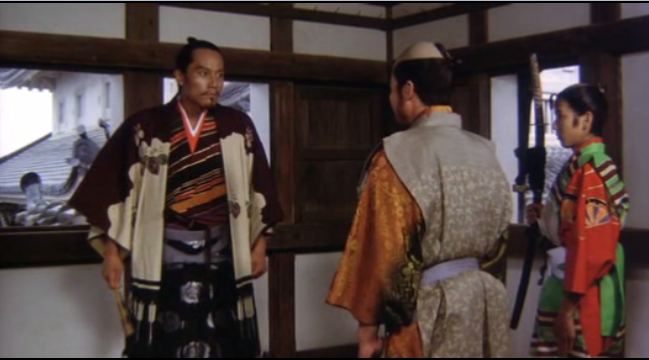
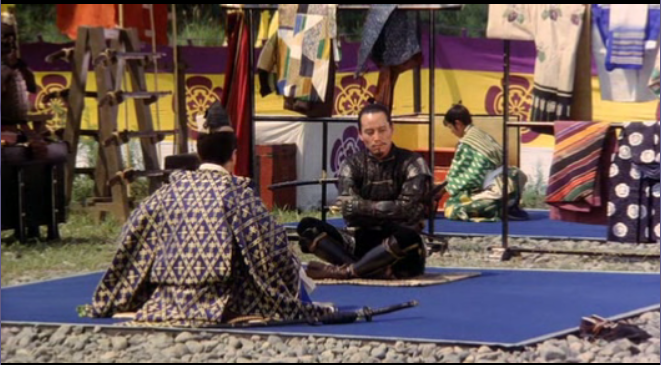
Note the patterns on the kimono behind Nobunaga. Another interesting Oda fashion fact: Nobunaga is also recognized as being one of the notable men of that time who preferred to wear European-style armour, instead of the traditional samurai-style armour you may be used to seeing.
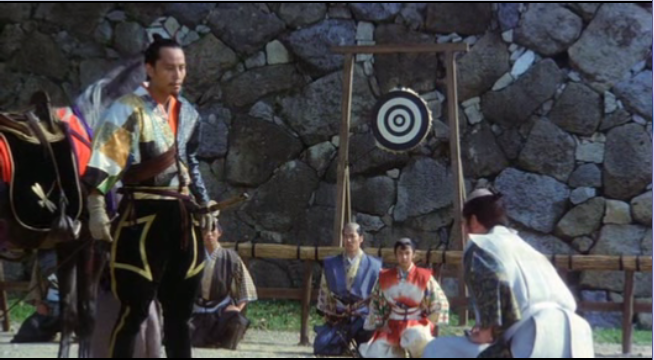
It brings me joy to know that, in a wonderful and faithful adaptation of this time by Kurosawa Akira, the shirt that Nobunaga is wearing is still inescapably 80's.
You may wonder why Nobunaga was wearing a coat with only one sleeve. In fact, he is noted as wearing several jackets with just one sleeve quite often. Nobunaga's love of archery is to blame for this. At the time, archers wore traditional Japanese clothing and armour in battle, and were forced to pull their sleeves out from below the tightly-tied armour, which Nobunaga said made him feel like he was in a straight-jacket. The solution to this was to simply lower the sleeve of the coat and inner clothing where the bow was held, so that it would not get tangled, and then putting on the armour. This whole thing would then hang off the side during the battle, much to the advantage of the modern pink film featuring female archers. Having enough of this whole thing, Nobunaga had commissioned for him clothing without sleeves, so that he wouldn't have to bother with any of that sort of thing. It's even said that he made some of his jackets personally. So, after getting his Project Runway on, he would enter battle without any extra bits of fabric hanging around and distracting him. It's actually kind of ingenious, huh?
It's also worth mentioning that, during this time, he was also criticized on his hairstyle, choosing to wear it in a topknot 'like some lowly ronin' (a jab at him being lord of a small country province), instead of the traditional chonmage with shaven pate.

Regardless, he was still notorious for his decision to wear such flashy, flamboyant and eccentric-looking clothing that inspired others to declare him the lord of the idiots.
Nobunari:
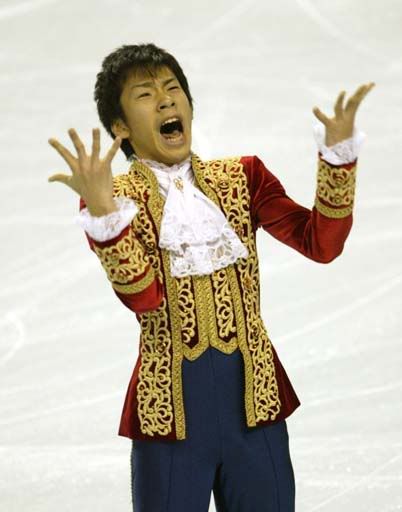
Yeop.
He has a habit of wearing garish costumes for dopey little theme numbers, bedazzled beyond recognition and hopelessly endearing him to the media/judges/middle aged ladies who make happy heart and star signs for him.
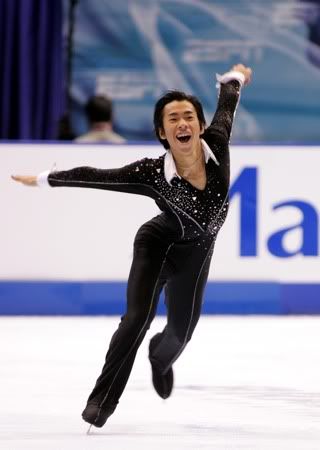
However, I did also witness a Frenchman dressed as a jockey whip an imaginary horse around the rink, so I guess this sort of thing is just par for the course for male figure skaters.
Come to think of it, Nobunari's usual outfit is this bizarre form-fitting full-length black bodysuit, not entirely unlike the costume Nobunaga wears in Samurai Warriors. So...

National Shame
Obviously, to live a live in the public eye, that of a lord and general in feudal wartime, or the descendant of such a man in the world of competitive figure skating, you have to carry a burden or two, resulting in the occasional glaring flaw. People have a habit of remembering the worst of someone, so any misstep will become international tabloid fodder. So what black mark does history leave on the pages of the Oda?
Nobunaga:
Nobunaga is remembered as the Demon King, and portrayed as a fearsome and coldblooded murderer with no sense of morality or honour. But, the man had to fight for everything he had in an era where absolutely everyone had to struggle for control in an attempt to unify the land. What would Japan be like today if nobody had stepped up and brought the people together? In this warring time, it was kill or be killed, and many clans were lost to history for refusing to fight, or not fighting well enough. Nobunaga just did what he had to, as everyone had to, why in the world would he be remembered as such a terrible man, and called the embodiment of the devil?
Well, he spent a good amount of his life fighting and slaughtering monks.
It's true that they were warrior-monks, a fanatical sect who had a larger variety of weapons and armour than most daimyo of the time, and had even managed to wrest a province out from under several daimyo. It's also suggested that they didn't exactly live a holy life, partaking in acts that even a non-monk could tell you was no good at all, and that they embraced any attack against them as a chance to expand their territory and control, and would take over all of the treasure of whomever they bested, and have all of their fortresses rebuilt for free at the cost of the imperial palace. Nobunaga saw these actions as blasphemy, the monks using their special privileges for their own personal gain, and not upholding the heraldry of Buddha, which was what the mountain had been designated for in the first place.
But whether this is true or not, the stone cold fact of the matter is that the Ikko-Ikki were able to hold off the then-powerful forces of Nobunaga for over a decade, and allied themselves with the monks of Hieizan, who lived atop a mountain near the capital of Kyoto. Their fortresses were located in the strategic "Demon Gate" location in accordance with feng shui, which would protect the capital and cleanse them of evil. The warrior-monks (souhei) wished to expand their prominence, and made a play for power, basically to prevent any opposing religions the opportunity to garner a position like they had. At this point, Nobunaga made a move against them, intervening and having that little idea tossed right out of the court. The Hieizan souhei allied themselves with the 'unconquerable' Ikko-Ikki sect, and made it known that they opposed Nobunaga, citing him as a demon among men and a threat to Buddhism, since he had taken some of their land at one point, and would stand against him expanding his power in Kyoto any longer. They then allied themselves with his brother-in-law by political marriage, and fought his troops while Nobunaga was away, resulting in the deaths of one of his trusted retainers, Mori Yoshinari, Ranmaru's father, as well as Nobunaga's brother.
It was here that Nobunaga made the very hard and controversial decision to quell these rebellions once and for all. The fanatical souhei had been given free reign in a way, knowing full well that any land that they felt they deserved (for religious reason or otherwise) and any power they wished to exert in the capital, would be granted them, because who would ever attack a monk? The court had been forced to give them no consequence, however the Shogun, who had returned to his place of power thanks to Nobunaga, and was now becoming rather annoyed with the fact that he 'owed' Nobunaga, decided that he would rather be forced to submit to the whims of the souhei rather than the Oda. Nobunaga, who came to the conclusion that no man could unite the country while these monks (a "third force" of opposition for the daimyo of the time) continued to hold such a strong place. And that was why he decided that, since someone had to step up and become the Demon King and enemy of these warrior monks, it might as well be him. In his mind, he believed that he had been designated by Buddha to make an example of what would happen to those who hid behind the banner of religion and acted evil, and that he would do what generations of men before him had been too afraid to do, and oppose the supposed blight on the battlefield of the country. Obviously, this decision wasn't well received among even his own men, but, to Nobunaga, it was just something that had to be done.
At least it is worth saying that these weren't your wise, thoughtful monks in holy garb asking for alms along the road. They looked something like this:


I don't know about you, but I would be fucking afraid.
Nobunaga decided to make a point of these campaigns, utilizing such tactics as cutting off all supplies and starving the monks to death, beheading the abbot when he came to surrender and beg him to spare their lives, setting their fortresses on fire, and also ordering his men to cut down every man, woman and child in the fortress, and then setting the whole thing on fire. It certainly did set an example of what would happen to those who opposed him. Hieizan had simply allied themselves in opposition of him, relatively defenseless atop the holy mountain, and Nobunaga's actions, though justified in theory, would cement his legacy, not only as the first unifier of Japan, but as the Demon King as well.
Nobunari:
Nobunari hasn't mercilessly slaughtered any holy men, but he has on occasion wholly embarrassed himself internationally.
Back in 2007, Nobunari was arrested. !!!
Yeah, and not only that, but he was forced to apologize to the skating federation as well as the country, and was removed from competition and appearances for the entire skating season that year. !!!
What a badass! What a cool guy! What awesome thing did the darling of the figure skating world do to incur this sort of media backlash?
Welp, the descendant of the Demon King was pulled over for driving drunk on his moped.
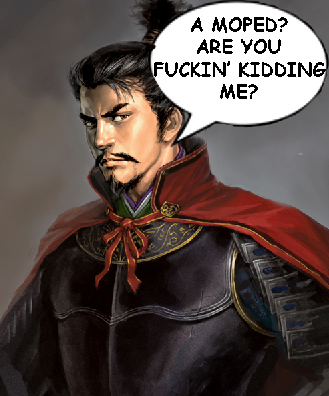
This image is courtesy of Disgrasian. The site goes on to tell us that his reasoning for drunk mopedding was that he usually gets his mom to come pick him up, but had misplaced his mobile.
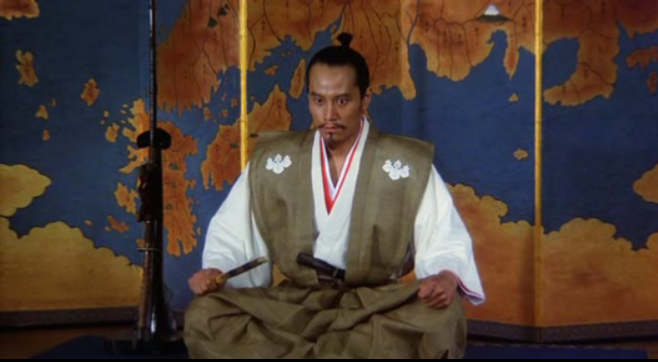
But believe it or not, that's not the worst thing he's done to Nobunaga's legacy.
Nobunari gained international fame, not for his skating moves, but for what happened when he got off the ice.
He got so happy that he cried. He cried like a little girl. Repeatedly.
Clips of this were seen far and wide, where it was announced that this young skater was a descendant of great warlord Oda Nobunaga (cool!), and had been skating a program to the music of Zatoichi (awesome!!!), and had burst into tears and needed to be held by his mother because he got a personal best score (lame).
Watch it in its entirety below. It gets worse as time stretches on.
All of which flesh out the first several pages of his name on Google image search.
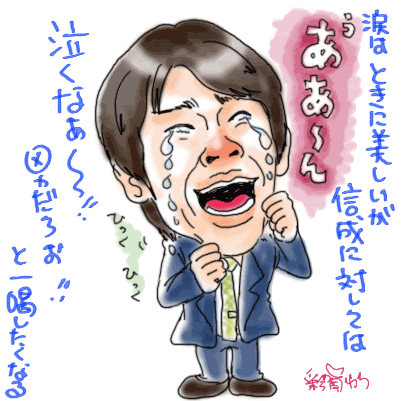

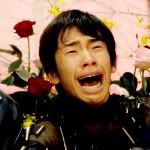
How sad, how hilariously sad.
All of this brings us to the inevitable question:
Is He Gay?
Nobunaga:
The fact that Nobunari exists is unequivocal proof that Nobunaga had sex with a woman. Nobunaga's wife was stated to be beautiful and possessing an intelligence that had few equals. Nobunaga said this himself! Of course, he said it on their wedding day, and the mistrust of the Saito caused him to become suspicious of her, and she supposedly exposed herself as a spy when he purposefully leaked her some false information that he had allied himself with two of her father's trusted retainers, and these two men were later killed on accusations of treason by Dosan. This probably isn't true, but the fact of the matter was that, at that point his wife had been unable to bear him children and was seen as barren, and now a traitor to the Oda, so he never spoke to her again and left her in her family castle after taking over her province, and history tells us no more of what happened to her.
But Nobunaga did have upwards of twenty, count them, twenty children bore to him by two different concubines, Kitsuno and Sakashi. And despite all of this, he would at any given time be 'deeply in love' with either one of them, and have things commissioned in their honour as 'the only woman he ever loved', depending on however he was feeling that week. So it only stands to reason that he was a great example of how a warlord should be during this time, and insinuating that he was homosexual is insulting and obviously not the case.
But this does not change the fact that Nobunaga had sex with a man.
This man.
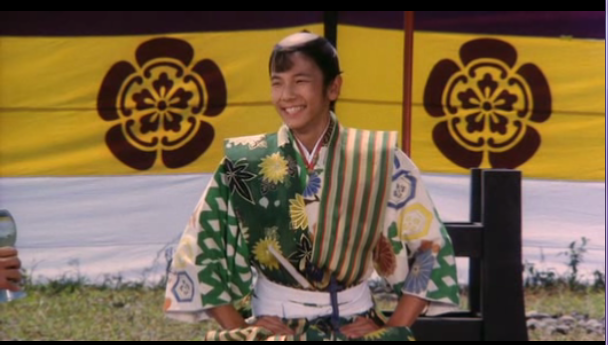
Mori Ranmaru, the most famous sandal-bearer in the whole world. You saw him present in the model of Atsumori up there, and if you look at all of the photos of him in Kagemusha, you'll notice this guy looming in the background. He was Nobunaga's page, or valet, or attendant, or whatever useless title you want to give the boy.
In Kagemusha, the young man playing Ranmaru exerts some of the most methodical acting skills you've ever seen. He's present in almost every scene with Nobunaga, lurking in the background and gazing lovingly up at Nobunaga, if not running around and serving him something or carrying Nobunaga's personal stool to different places for him to sit.
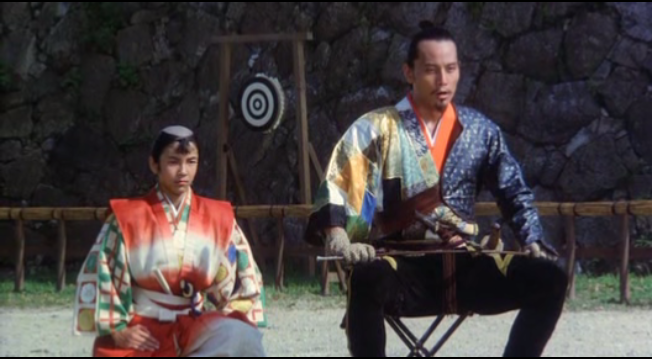
Ranmaru was known far and wide for his 'talent' of being so in tune with Nobunaga, going to the stable and bringing a specific favourite horse around even before he is summoned to do so by Nobunaga. The whole thing sounds pretty creepy, right?
Believe it or not, this sort of thing was not only common, but encouraged among daimyo and samurai and noblemen alike. In several of the books written on how to best be a samurai or a man of honour, this practice, called shudou, was noted as a useful aspect of noble culture. Supposedly, it would train the younger boy in the skills he would need to become a capable man and warrior, teaching him valuable lessons in the appreciation of beauty, virtue and honour. In return, the older man was seen in a position of strength and valor, engaging in a practice even monks would partake in, believing it to curb the feminine corruption of women, that could distract a man from the way of the warrior.
So, if basically all of these famous samurai generals did this sort of thing, why is Ranmaru so popular and remembered in modern representations of that life?
Ranmaru himself would choose to commit seppuku alongside Nobunaga at his death, and this loyalty is significant to his practice of shudou, earning him praise and respect for his supreme loyalty and belief to the way of the Hagakure.
Regardless, he is portrayed in Samurai Warriors like this:

and that's gay.
Nobunari:
I've given Nobunari a lot of grief throughout this entry, but I will stand by my assessment that mens' figure skating features waaaay more themed outfits and showboating than even womens' figure skating, and more closely resembles the ice capades than any sort of real sport. Obviously, for this sort of thing, you have to begin training at a very young age, but those who continue to remain in the fabulous world of figure skating as they get older and older and no longer do any jumps or anything but dress up and prance around at age 40 obviously have something going on.
In fact, watching these men from countries where it wasn't about winning the gold, but instead 'felt the need to return to the sport to express themselves creatively as best they knew how', was pretty uncomfortable. Google "Johnny Weir" if you want an example. Every time he or some other dude showed up wearing what was basically a pink corset or frilly shirt and sounding all womanly in interviews, the commentators would say that he was 'unique'. They said this about several different guys who acted just like that. They did not call Nobunari unique, however, so that's good, but they did talk about how soft his knees were and how strong his thighs were, but that's more on their heads than his.
I don't know if Nobunari has a girlfriend, or what his personal life choices are. But you know what? I'm going to give him the benefit of the doubt and go on the record as saying that he probably has a smoking hot girlfriend and is 100% heterosexual, but he is still really, really gay.
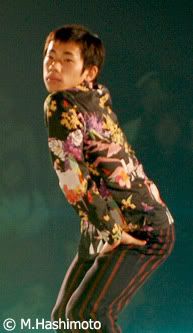
Somehow takes after Ranmaru's side of the family.
The Last Battle
Nobunari:
Nobunari was most recently bested by this man from the Czech Republic:

You know, every photo I see of a male figure skater is just like the funniest fucking thing ever. That's great.
Nobunaga:
Nobunaga's death is iconic in the fact that this near-unstoppable man was inevitably stopped by one of his own retainers, who staged a coup. This retainer, Akechi Mitsuhide, had his reasons, reasons that nobody was really certain of. The general consensus is that he was extremely appalled at what Nobunaga did to the warrior monks. However, Akechi Mitsuhide was actually one of the generals who did the killing, and after his 'I wasn't there' story was disproved, he would switch it up by saying that he 'was forced to commit the murders against his will', and later 'had just really strongly disagreed with it at the time and now that he had the chance to think about it he decided it was just really wrong, you know?' Other reasons for his betrayal are cited, for example, perhaps he had decided that he would be a better ruler, now that he had a foothold and Nobunaga's now-powerful army to simply take right over once Nobunaga was dead. Another thought is that he bore a personal grudge against Nobunaga, and that Nobunaga had yelled at him for being useless during a dinner in front of others, and it had embarrassed him.
Way back in the day, he had been a retainer of several other lords, and had subsequently abandoned them in their time of need, or went on to betray them in order to move onto the next lord whose favour he hoped to curry. At one point, he would approach the Asakura clan for employment, and was given a small position and then dismissed, basically a polite way of saying 'Here, we gave you a little title, and now we don't need you, please go away' in the kindest possible situation. Asakura's reasoning for disposing of him quickly went as follows: He found Mitsuhide to be a charming, intelligent, talented and captivating man. As he explained to one of his retainers, he believed that there were two kinds of great men, a noble conquerer and a villain. He felt that if a villainous man was also a scholar, as Mitsuhide was, then he could only bring himself and his lord to ruin. Mitsuhide would later betray the Asakura in order to become a retainer for Nobunaga.
On June 21, 1582, just two days before Nobunaga's 48th birthday, Mitsuhide surrounded Nobunaga at Honnouji, a temple in Kyoto that Nobunaga would stay at when he visited the capital. Mitsuhide delivered his iconic quote, "Teki wa Honnouji ni ari!" (The enemy is at Honnouji)
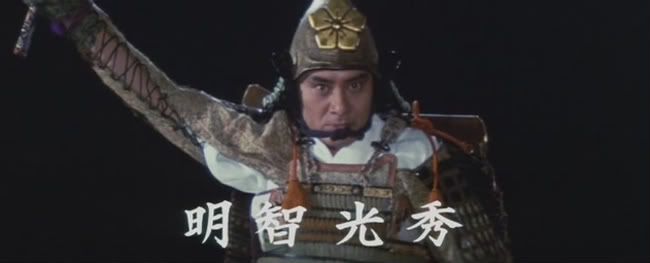
and burned the place to the ground, forcing Nobunaga, his retainers, and his oldest son and heir to commit seppuku.
Mitsuhide would later be killed in battle by Nobunaga's other retainer, Toyotomi Hideyoshi, less than two weeks later.
So that was the last word on the life of Oda Nobunaga, until 400 years later when he would be mentioned on TV as being related to the male figure skater up next in the program.
But in all seriousness, thank you all so much for reading, hopefully enjoying and learning as well. I wish Nobunari the very best at the upcoming Olympics. Do your best, you crazy ice dancer!

No comments:
Post a Comment